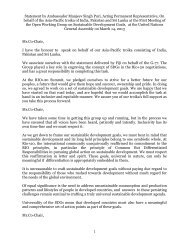STATE OF THE WORLD'S CITIES 2012/2013 Prosperity
STATE OF THE WORLD'S CITIES 2012/2013 Prosperity
STATE OF THE WORLD'S CITIES 2012/2013 Prosperity
Create successful ePaper yourself
Turn your PDF publications into a flip-book with our unique Google optimized e-Paper software.
State of the World’s Cities <strong>2012</strong>/<strong>2013</strong><br />
FACT<br />
Cities that succeed<br />
in fostering the<br />
exchange of ideas and<br />
innovations are able to tap<br />
into growth dynamics that<br />
fuel the creation of social<br />
and intellectual capital,<br />
thereby further contributing<br />
to their productivity.<br />
POLICy<br />
Cities that<br />
succeed in<br />
educating, attracting<br />
and retaining creative<br />
individuals are more likely<br />
to prosper, as they not only<br />
generate new ideas and<br />
products but, in turn, also<br />
attract high-value added<br />
firms, such as knowledgebased<br />
industries.<br />
Some cities are<br />
strengthening comparative<br />
advantage by showcasing<br />
their tangible and<br />
intangible heritage and<br />
exploiting their cultural<br />
identity, in an effort to<br />
bring about social and<br />
economic transformation. 20<br />
Doha, for example, is<br />
developing education and<br />
arts as part of the city’s new<br />
cultural vision. 21 Gaziantep<br />
in eastern Turkey has<br />
started to use cultural<br />
heritage as a touristic<br />
asset for the purposes<br />
of increased prosperity.<br />
Heritage restoration and<br />
rehabilitation enhance<br />
quality of life while<br />
contributing to economic<br />
development. 22<br />
Talent, in turn, is a<br />
function of the quality of<br />
school systems and higher<br />
education. Many cities in<br />
the developing world are<br />
faced with brain drain<br />
due to lack of local and<br />
national policies to retain<br />
highly qualified individuals.<br />
With the exception of<br />
Asia, where about half of<br />
the local experts perceive<br />
that cities are making<br />
efforts to retain talent, the<br />
proportions are alarmingly<br />
low in other regions.<br />
There are exceptions,<br />
though: Dubai emphasizes<br />
higher education and<br />
training in engineering and<br />
information technologies. 23 Chongqing has developed an<br />
ambitious training programme to support the transition of<br />
rural migrants from manual-based to skill-based types of<br />
work; by 2009, nearly one-third of migrants had benefited<br />
from the scheme. 24<br />
A city’s existing<br />
FACT talent pool is<br />
a major determinant of<br />
productivity. The more<br />
highly skilled a city’s<br />
population, the more likely it<br />
is to attract more talent.<br />
By offering an<br />
POLICy environment<br />
conducive for Research and<br />
Development, cities can be<br />
key players in a knowledgebased<br />
economy, as there<br />
is a direct link between<br />
Research and Development,<br />
technology and productivity.<br />
44<br />
Some cities in developing countries have embraced<br />
the model of world-class innovation clusters, such as<br />
California’s Silicon Valley or Boston’s Route 128, to become<br />
‘high-tech hubs’. Those that have met with success in<br />
this endeavour, such as India’s Bangalore, owe it to the<br />
same basic factors: the presence of top-quality academic<br />
and research institutions as well as substantial public and<br />
corporate investment. However, some observers claim<br />
that the city needs to pay more attention to infrastructure<br />
development and to ensure that the benefits of growth are<br />
more evenly distributed across all the population.<br />
Quality of life is rapidly emerging as a major asset<br />
in any efforts to attract and retain creative minds and<br />
businesses. It comes as no surprise that Toronto, San<br />
Francisco or Stockholm should consistently rank among<br />
the top performing cities in the world, since they are found<br />
as performing particularly well in a wide range of both<br />
economic and quality of life indicators, crime, green areas,<br />
air quality and life satisfaction. Outside the more developed<br />
nations, Singapore, with a similar balance of quality of life<br />
attributes, also ranks among the top world cities and the<br />
highest among developing countries.<br />
URBAN PRODUCTIvITy: SOME CHALLENGES<br />
While China’s urban population increased from 17 to<br />
39 per cent within a span of 40 years (from 1963 to 2003),<br />
the same change in urban population took 120 years in<br />
Great Britain and 80 years in the USA. 26 Cities in more<br />
advanced countries are better positioned to capitalize on<br />
the agglomeration economies associated with population<br />
growth. This is not just because that growth is more<br />
manageable (typically around one per cent per year); but<br />
also because, as suggested by their high GDP per capita,<br />
these cities already have the physical and institutional<br />
support needed to capitalize on that demographic<br />
potential. Such capacities are generally not available in<br />
developing countries,<br />
leaving fast-expanding<br />
cities more exposed<br />
to the agglomeration<br />
diseconomies which<br />
prevent them from<br />
fully capitalizing on the<br />
productivity potential<br />
associated with sustained<br />
population growth<br />
(typically an annual rate<br />
of two to four per cent or<br />
FACT<br />
Top performing<br />
cities derive<br />
their strengths not<br />
just from their status<br />
as global economic<br />
powerhouses or<br />
from sophisticated<br />
infrastructure, but<br />
also from their ability<br />
to enhance quality of<br />
life. 25




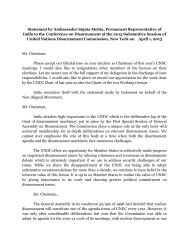

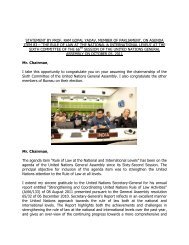

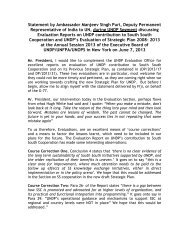


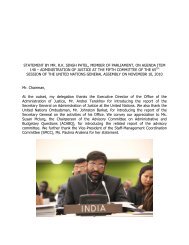

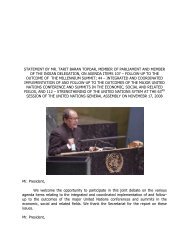

![1 statement by dr.[mrs] kakoli ghosh dastidar - Member States Portal](https://img.yumpu.com/27526598/1/190x245/1-statement-by-drmrs-kakoli-ghosh-dastidar-member-states-portal.jpg?quality=85)
